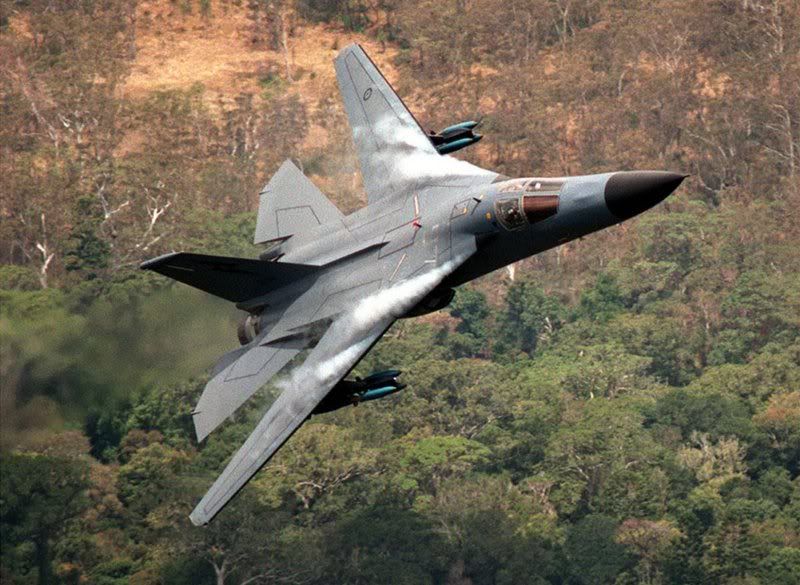
Posted on 03/03/2010 8:26:45 PM PST by sukhoi-30mki
Air Force wants old F-111 strike bombers destroyed
Cameron Stewart
THE Royal Australian Air Force is looking for someone to do what the Soviet Union could only dream of during the Cold War -- destroy its F-111 strike bombers.
The Defence Department has issued a tender to turn half its F-111 fleet -- the pride of the RAAF for a generation -- into what will surely be the nation's most expensive scrap metal.
It will be an undignified end to the warplane, known affectionately as the "pig", which was ordered by Robert Menzies in 1963 with the requirement that it be able to drop a nuclear bomb on Jakarta if necessary.
Thirteen of the bombers and their engines will be destroyed after they are retired at the end of this year.
It is unclear what will be done with the remainder of the F-111 fleet. There are 15 F-111Cs in operation and 12 F-111Gs in storage, plus two used for spares.
A public tender issued by the Defence Materiel Organisation calls for the smashing of the historic planes, despite the fact they would be popular exhibits outside RSL clubs around the country. "The commonwealth requires a proposal for physical destruction of the following equipment; (a) quantity 13 F-111G aircraft (approximately 20 tonne per aircraft) held at RAAF Base Amberley and; (b) quantity 70 TF-30 engines (approximately 2 tonne per engine) held at RAAF Base Amberley," the tender says.
Defence was unable to respond in time yesterday to The Australian's questions about why the planes were being destroyed rather than donated to ex-service bodies or museums.
The F-111 fleet was grounded for two weeks last month after an engine caught fire on one during a flying display at the Singapore Airshow. The fleet has been cleared to fly again, but is expected to be placed on limited operations until the planes are retired later this year.
The strike bomber had a controversial beginning, arriving in Australia in the early 1970s, years late and at more than four times the estimated cost, but it has since proved a highly effective plane for the RAAF.
The bombers will be replaced by a squadron of 26 F/A-18 Super Hornets, the first of which will arrive in Australia this week.
Keep the best ones around as backup. Scrap the ones that arent and take anything useful off of them for spare parts for the ones that are good. They would be better than nothing if your top of the line aircraft are gone.
Keep the best ones around as backup. Scrap the ones that arent and take anything useful off of them for spare parts for the ones that are good. They would be better than nothing if your top of the line aircraft are gone.
Sad end for an Aardvark, why it’s almost as bad as being roadkill
...ah the good old days of the Cold War.

 i guess turning them into photo reece/jammer planes is out of the question...
i guess turning them into photo reece/jammer planes is out of the question...
I wonder has the Royal Australian Air Force seriously looked at buying the F-15E Strike Eagle to replace the F-111s or are they still going with the buy for the F/A-18F Super Hornet.
Rig them up as remote controlled drones.
They could always be used in a fake attack or diversion.
.
Why not sell them?
Great picture. I did not realise the back wings pitched like that instead of flaps. 1960s/1970s technology but still pretty amazing.
Air show rides in older jets get about $100-$200 a pop.
Why not disable any ability to weaponize and sell for a few hundred grand?
maybe they can turn them in on Obamas “Cash for Clunkers “ program
Congress wanted the Navy to accept this plane for carrier operations, prompting the secretary of the Navy to say “all the horsepower in Christendom won’t make this plane a fighter”.
Do a flyover of Libya and scare the crap out of Q-daffy.
Nobody would want them. Metal fatigue and lack of spare parts unique to the plane make them close to being flying coffins. That's why so many of our own planes are sitting in the boneyard waiting to be scrapped.
I read an article somewhere about what it took to maintain one of those things. The swing wings are attached to a massive aluminum casting that provides pivot points for the wings. After so many flight hours the planes have to be torn apart to get that casting out and onto a work bench. Then they spend days hand sanding off all the paint and primer to get it down to bare metal, and then hand sand it for days more to make the surface smooth as glass. This is the only way to retard the growth of surface fatigue cracks, and there are no more of those casting in existence except in those airplanes.
This would be like once a year tearing your car apart to separate everything from the frame. Then, hand sand the whole frame until it's smooth as glass, reprime and repaint it, reinstall everything you took off, and you're good for another year or so.


Yes an eventually that metal fatigue reaches deep inside those castings/forgings whether aluminum/steel/titanium and the entire thing becomes work hardened to the point where one day it just snaps under load (without the surface cracks).
I suspect that accelerating fatigue hardening of the center wing box casting was one thing that hastened the retirement of the F-14 also.
Disclaimer: Opinions posted on Free Republic are those of the individual posters and do not necessarily represent the opinion of Free Republic or its management. All materials posted herein are protected by copyright law and the exemption for fair use of copyrighted works.